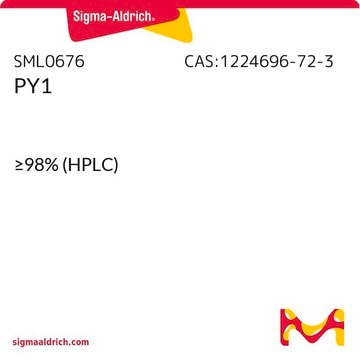53271
Mito Red
suitable for fluorescence, ≥70% (HPLC)
Synonim(y):
3,6-Bis(diethylamino)-9-[2-(4-methylcoumarin-7-yloxycarbonyl)phenyl]xanthylium chloride, Rhodamine B 4-methylumbelliferyl ester chloride
About This Item
Polecane produkty
Próba
≥70% (HPLC)
Postać
solid
fluorescencja
λex 569 nm; λem 594 nm in DMSO
przydatność
suitable for fluorescence
temp. przechowywania
2-8°C
ciąg SMILES
[Cl-].CCN(CC)c1ccc2c(-c3ccccc3C(=O)Oc4ccc5C(C)=CC(=O)Oc5c4)c6ccc(cc6[o+]c2c1)N(CC)CC
InChI
1S/C38H37N2O5.ClH/c1-6-39(7-2)25-14-17-31-33(21-25)44-34-22-26(40(8-3)9-4)15-18-32(34)37(31)29-12-10-11-13-30(29)38(42)43-27-16-19-28-24(5)20-36(41)45-35(28)23-27;/h10-23H,6-9H2,1-5H3;1H/q+1;/p-1
Klucz InChI
XCVSDCPWJRHMSZ-UHFFFAOYSA-M
Powiązane kategorie
Opis ogólny
Zastosowanie
Kod klasy składowania
11 - Combustible Solids
Klasa zagrożenia wodnego (WGK)
WGK 3
Temperatura zapłonu (°F)
Not applicable
Temperatura zapłonu (°C)
Not applicable
Środki ochrony indywidualnej
Eyeshields, Gloves, type N95 (US)
Certyfikaty analizy (CoA)
Poszukaj Certyfikaty analizy (CoA), wpisując numer partii/serii produktów. Numery serii i partii można znaleźć na etykiecie produktu po słowach „seria” lub „partia”.
Masz już ten produkt?
Dokumenty związane z niedawno zakupionymi produktami zostały zamieszczone w Bibliotece dokumentów.
Klienci oglądali również te produkty
Produkty
Nitric oxide (NO) as a signal transporter in neurons, endothelial cells and in the immune system.
Nasz zespół naukowców ma doświadczenie we wszystkich obszarach badań, w tym w naukach przyrodniczych, materiałoznawstwie, syntezie chemicznej, chromatografii, analityce i wielu innych dziedzinach.
Skontaktuj się z zespołem ds. pomocy technicznej










